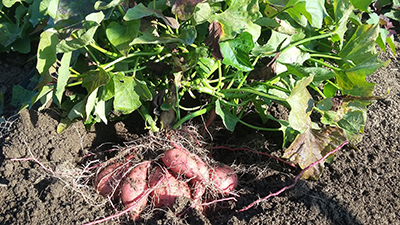Ipomoea batatas L. Lam. (Convolvulaceae) cv. Beauregard



| ENG | Sweet potato |
| SK | batát (syn. sladký zemiak) |
| CZ | batat (syn. sladký brambor) |
| PL | batat (syn. słodki ziemniak) |
| HU |
Using
Carotenoid-rich food (mainly cultivars with orange flesh colour); anti-diabetic, anti-oxidant and anti-proliferative properties; higher glycemic index (unsuitable for diabetics and overweight persons); higher ratio of simple sugars compared to classical potatoes; low ratio of proteins and fats; Sweet potato cultivars with an orange or yellow flesh contain significant amounts of carotenoids which are known as provitamins A (Allen et al., 2012).
| I. | II. | III. | IV. | V. | VI. | VII. | VIII. | IX. | X. | XI. | XII. | |||||||||||||
| Planting | ||||||||||||||||||||||||
| Harvest | ||||||||||||||||||||||||
Botanical description and occurrence:
Sweet potato 'Beauregard' is a cultivar with vegetation period from planting to harvest in the range from 90 days (southern areas of Europe and world) to 120 days approximately (Slovakia conditions). It was developed at Louisiana State University in 1987´. Sweet potato is crop requiring sunny place and vegetation period without freeze. Sweet potato should be cultivated grown in hillock system as it is typical for carrot cultivation. Recommended distance between rows (hillocks) is 1.20 m; narrow distance (minimally 1.0 m) could be used in small gardens. Prepared or bought seedlings should be planted in row into the distance of 0.30 m. Mulching by black non-woven textile, PE foil or organic materials (straw etc.) is recommended for cultivation, mainly and necessarily in conditions of Slovak republic or middle European countries.
Why to have the plant in your garden:
This cultivar is probably the world’s most popular sweet potato. It is favoured for high yields of uniform, reddish-purple potatoes with tasty, deep-orange flesh that keeps well in storage.
Text:
Dr. Mirsolav Šlosár, SUA, Nitra (Slovak Republic)
Photo:
Dr. Ivana Mezeyova, Dr. Miroslav Šlosár, SUA, Nitra (Slovak Republic)

